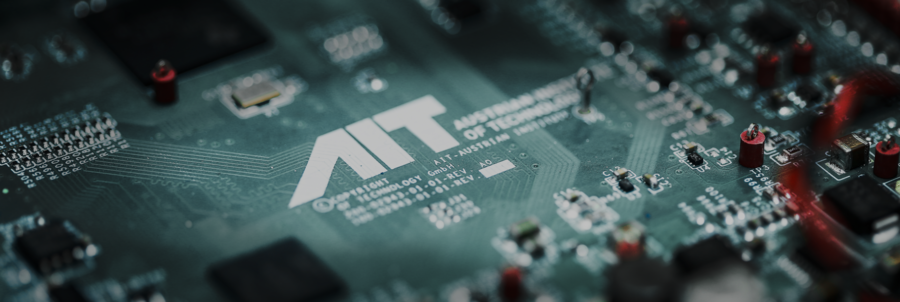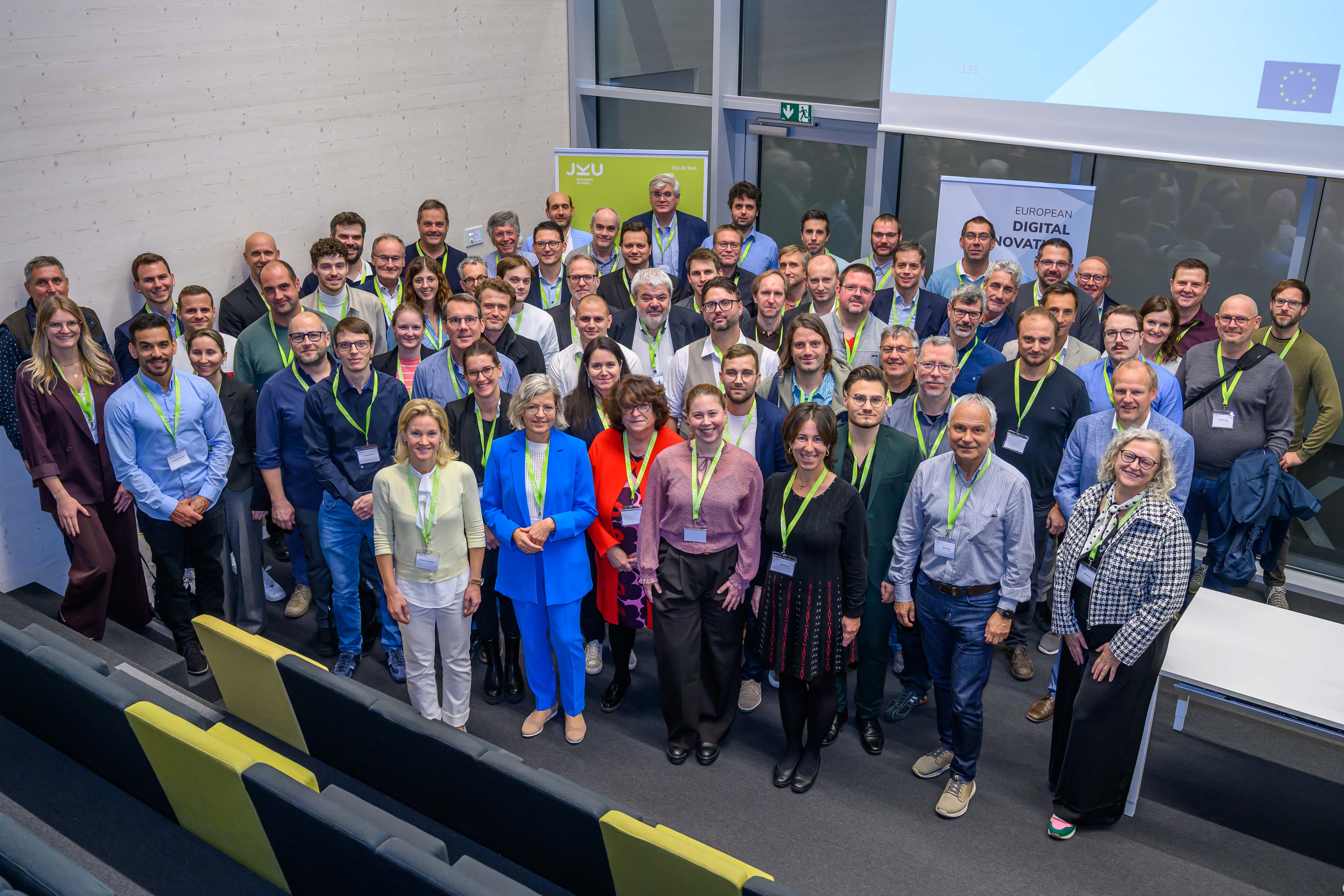AIT at the AI5Production Symposium 2025
The European Digital Innovation Hub EDIH AI5Production supports companies in meeting today’s digital challenges with the overarching goal of enabling sustainable, resilient and human-centred production systems in line with Industry 5.0.
On 15 October 2025, EDIH AI5Production, organiser of the AI5Production Symposium, hosted the event at Johannes Kepler University Linz under the theme “Digitalisation in production: solutions and applications”. Leading experts, users and decision-makers from industry and research discussed concrete experiences, technologies and perspectives from the AI5Production initiative.
AIT presented four posters, impressively demonstrating the intertwining of digitalisation, sustainability and technological innovation in production, showcasing everything from digitally integrated building technology and circular photovoltaics to energy-efficient welding processes and innovative forming technologies for light metals.
Poster 1) Digital data consistency for drive technology in building services engineering
Data for sustainable construction and operation
The "DRIVE_THRU" project aims to improve data consistency in TGA (technical building equipment) planning and, at the same time, integrate sustainability aspects such as life cycle analysis (LCA) and circular economy principles directly into digital planning processes.
Methodology:
- Combination of digital and ecological analyses of building components throughout their entire life cycle – using products from Belimo as an example
- Quantitative calculation of environmental impacts in accordance with EN 15804
- Integration of environmental product declarations (EPDs) into BIM models
Results:
The project enables a transparent and verifiable representation of a product's environmental impact throughout its entire life cycle. These verified key figures (Environmental Product Declarations – EPDs), such as carbon footprint, energy consumption and recycling rate, are integrated directly into BIM models so that planners and operators can take ecological optimisations into account at an early stage of the design process.
This means that, for the first time, sustainability metrics can be automatically incorporated into the planning of technical systems – a decisive step towards digitally integrated and sustainable building technology.
Poster 2) Optical testing method for used PV modules
Billions of PV modules will reach the end of their service life in the coming years. However, many used modules remain functional.
In view of these growing quantities of used PV modules being returned, a scalable, automated testing method has been developed that makes reuse economically and ecologically feasible. It detects typical defects using optical methods.
Together with a Lower Austrian start-up, AIT developed an automated multi-sensor imaging system for the objective quality assessment of used PV modules
Methodology:
The system combines RGB and electroluminescence (EL) cameras with customised lighting to reveal defects such as cracks, delamination and bubbles. The components were validated under real-world conditions.
Results:
The solution has been successfully integrated into the 2ndCycle testing facility. It achieves a high detection rate at high process speeds and has proven its industrial suitability. Based on the results, an automatic reuse/recycling decision-making process is now being developed in a funded follow-up project entitled WattsOK? The project thus makes a significant contribution to the circular economy in the PV sector and can also be expanded in the future through AI-based defect analysis.
Poster 3) Efficiency improvements in TIG and plasma welding inverters
The third presentation focused on approaches to increasing energy efficiency in welding processes. The high energy demand of welding processes and their widespread use make welding one of the most energy-intensive applications in industrial manufacturing, as evidenced by an estimated final energy consumption of 6 TWh, corresponding to 2.4 million tonnes of CO2e, according to EU Directive 2019/1784.
However, this also results in a particularly large lever for optimisation. An interdisciplinary team of various experts from the AIT's Energy and VAC centres developed concepts for improvements.
Methodology:
- Survey of the status quo using the laboratory infrastructure at AIT
- Assessment of suitability for wide bandgap semiconductors
- Holistic consideration of all assemblies used in a welding inverter in order to develop innovative approaches for reducing semiconductor elements
- Use of tailor-made modern control technology to meet future and existing requirements with the new circuit layouts
Results:
As part of the project, the status quo was first assessed on a welding inverter that corresponds to the state of the art in the industry. Based on this, a concept was developed that uses modern technologies (semiconductor materials and control technology) in combination with innovative circuit designs to achieve considerable savings in resource consumption. This reduces both energy consumption and component requirements.
Poster 4) AI-supported dynamic control for optimising the electroplastic effect in metal processing
The DynamicAIControlEPE project is investigating an AI-supported image analysis system that enables adaptive closed-loop control of a forming process – specifically, a tensile test on aluminium samples (e.g. EN AW-5083). The application of pulsed direct current pulses (PWM-DC) with up to 40 kA at 12 V during forming activates the electroplastic effect (EPE), which reduces the yield stress, increases ductility and thus significantly increases the forming potential of the light metal.
Methodology:
The application consists of three main modules:
- Live tab: continuous monitoring of the forming process in real time
- Parameter calibration: optimisation of edge detection algorithms (Canny, RANSAC, curvature filter)
- Camera calibration: via a GUI – the region of interest (ROI) is defined, which corresponds to the initial measurement length of the tensile test specimen. Within this ROI, the two specimen edges are automatically detected and their distance calculated in real time – as a measure of the plastic thinning of the specimen.
Results:
The system enables reliable live control of edge measurement. AI inference takes less than a second, creating a continuous chain of local sensor technology → AI-supported image evaluation → adaptive actuator control. Current control is dynamic, based on the calculated strain state, which allows targeted control of the EPE effect.
The four poster presentations illustrate the broad spectrum of research at AIT in the field of digital, sustainable and AI-supported production technologies – from energy-efficient industry and resource-saving building technology to the circular economy in photovoltaics and forming processes in the light metal industry.
Accompanying the event, a symposium volume will be published that takes a closer look at the topics presented in the form of scientific articles.
We would like to thank the organisers of the AI5Production Symposium for a successful event and the inspiring exchange with colleagues from research and industry.
More about
AI5Production: ai5production.at
AIT @ AI5Production : www.ait.ac.at/ueber-das-ait/center/center-for-vision-automation-control/complex-dynamical-systems/projekte/ai5production
Copyright: JKU, Andreas Röbl Fotografie




